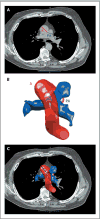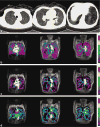Cardiopulmonary coupling in chronic obstructive pulmonary disease: the role of imaging
- PMID: 24552883
- PMCID: PMC4274316
- DOI: 10.1097/RTI.0000000000000076
Cardiopulmonary coupling in chronic obstructive pulmonary disease: the role of imaging
Abstract
Chronic obstructive pulmonary disorder (COPD) is a systemic disease that affects the cardiovascular system through multiple pathways. Pulmonary hypertension, ventricular dysfunction, and atherosclerosis are associated with smoking and COPD, causing significant morbidity and poor prognosis. Coupling between the pulmonary and cardiovascular system involves mechanical interdependence and inflammatory pathways that potentially affect the entire circulation. Although treatments specific for COPD-related cardiovascular and pulmonary vascular disease are limited, early diagnosis, study of pathophysiology, and monitoring the effects of treatment are enhanced with improved imaging techniques. In this article, we review recent advancements in the imaging of the vasculature and the heart in patients with COPD. We also explore the potential mechanism of coupling between the progression of COPD and vascular disease. Imaging methods reviewed include specific implementations of computed tomography, magnetic resonance imaging, dual-energy computed tomography, positron emission tomography, and echocardiography. Specific applications to the proximal and distal pulmonary vasculature, as well as to the heart and systemic circulation, are also discussed.
Figures










Similar articles
-
Cor pulmonale parvus in chronic obstructive pulmonary disease and emphysema: the MESA COPD study.J Am Coll Cardiol. 2014 Nov 11;64(19):2000-9. doi: 10.1016/j.jacc.2014.07.991. Epub 2014 Nov 3. J Am Coll Cardiol. 2014. PMID: 25440095 Free PMC article.
-
Management of COPD: Is there a role for quantitative imaging?Eur J Radiol. 2017 Jan;86:335-342. doi: 10.1016/j.ejrad.2016.08.022. Epub 2016 Aug 28. Eur J Radiol. 2017. PMID: 27592252 Review.
-
[Advances in chest imaging in early chronic obstructive pulmonary disease].Zhonghua Jie He He Hu Xi Za Zhi. 2023 Dec 12;46(12):1266-1271. doi: 10.3760/cma.j.cn112147-20230922-00190. Zhonghua Jie He He Hu Xi Za Zhi. 2023. PMID: 38044057 Review. Chinese.
-
Cardiovascular magnetic resonance imaging to identify left-sided chronic heart failure in stable patients with chronic obstructive pulmonary disease.Am Heart J. 2008 Sep;156(3):506-12. doi: 10.1016/j.ahj.2008.04.021. Epub 2008 Jun 17. Am Heart J. 2008. PMID: 18760133
-
Potential Applications of PET Scans, CT Scans, and MR Imaging in Inflammatory Diseases: Part II: Cardiopulmonary and Vascular Inflammation.PET Clin. 2020 Oct;15(4):559-576. doi: 10.1016/j.cpet.2020.06.010. Epub 2020 Aug 10. PET Clin. 2020. PMID: 32792228 Review.
Cited by
-
Potential Value of Expiratory CT in Quantitative Assessment of Pulmonary Vessels in COPD.Front Med (Lausanne). 2021 Oct 14;8:761804. doi: 10.3389/fmed.2021.761804. eCollection 2021. Front Med (Lausanne). 2021. PMID: 34722596 Free PMC article.
-
Czech multicenter research database of severe COPD.Int J Chron Obstruct Pulmon Dis. 2014 Nov 10;9:1265-74. doi: 10.2147/COPD.S71828. eCollection 2014. Int J Chron Obstruct Pulmon Dis. 2014. PMID: 25419124 Free PMC article.
-
Arterial Vascular Pruning, Right Ventricular Size, and Clinical Outcomes in Chronic Obstructive Pulmonary Disease. A Longitudinal Observational Study.Am J Respir Crit Care Med. 2019 Aug 15;200(4):454-461. doi: 10.1164/rccm.201811-2063OC. Am J Respir Crit Care Med. 2019. PMID: 30758975 Free PMC article.
-
Imaging Advances in Chronic Obstructive Pulmonary Disease. Insights from the Genetic Epidemiology of Chronic Obstructive Pulmonary Disease (COPDGene) Study.Am J Respir Crit Care Med. 2019 Feb 1;199(3):286-301. doi: 10.1164/rccm.201807-1351SO. Am J Respir Crit Care Med. 2019. PMID: 30304637 Free PMC article. Review.
-
Ventricular Geometry From Non-contrast Non-ECG-gated CT Scans: An Imaging Marker of Cardiopulmonary Disease in Smokers.Acad Radiol. 2017 May;24(5):594-602. doi: 10.1016/j.acra.2016.12.007. Epub 2017 Feb 15. Acad Radiol. 2017. PMID: 28215632 Free PMC article.
References
-
- Divo M, et al. Comorbidities and risk of mortality in patients with chronic obstructive pulmonary disease. Am J Respir Crit Care Med. 2012;186(2):155–61. - PubMed
-
- Minai OA, Chaouat A, Adnot S. Pulmonary hypertension in COPD: epidemiology, significance, and management: pulmonary vascular disease: the global perspective. Chest. 2010;137(6 Suppl):39S–51S. - PubMed
-
- Santos S, et al. Characterization of pulmonary vascular remodelling in smokers and patients with mild COPD. Eur Respir J. 2002;19(4):632–8. - PubMed
Publication types
MeSH terms
Grants and funding
LinkOut - more resources
Full Text Sources
Other Literature Sources
Medical

